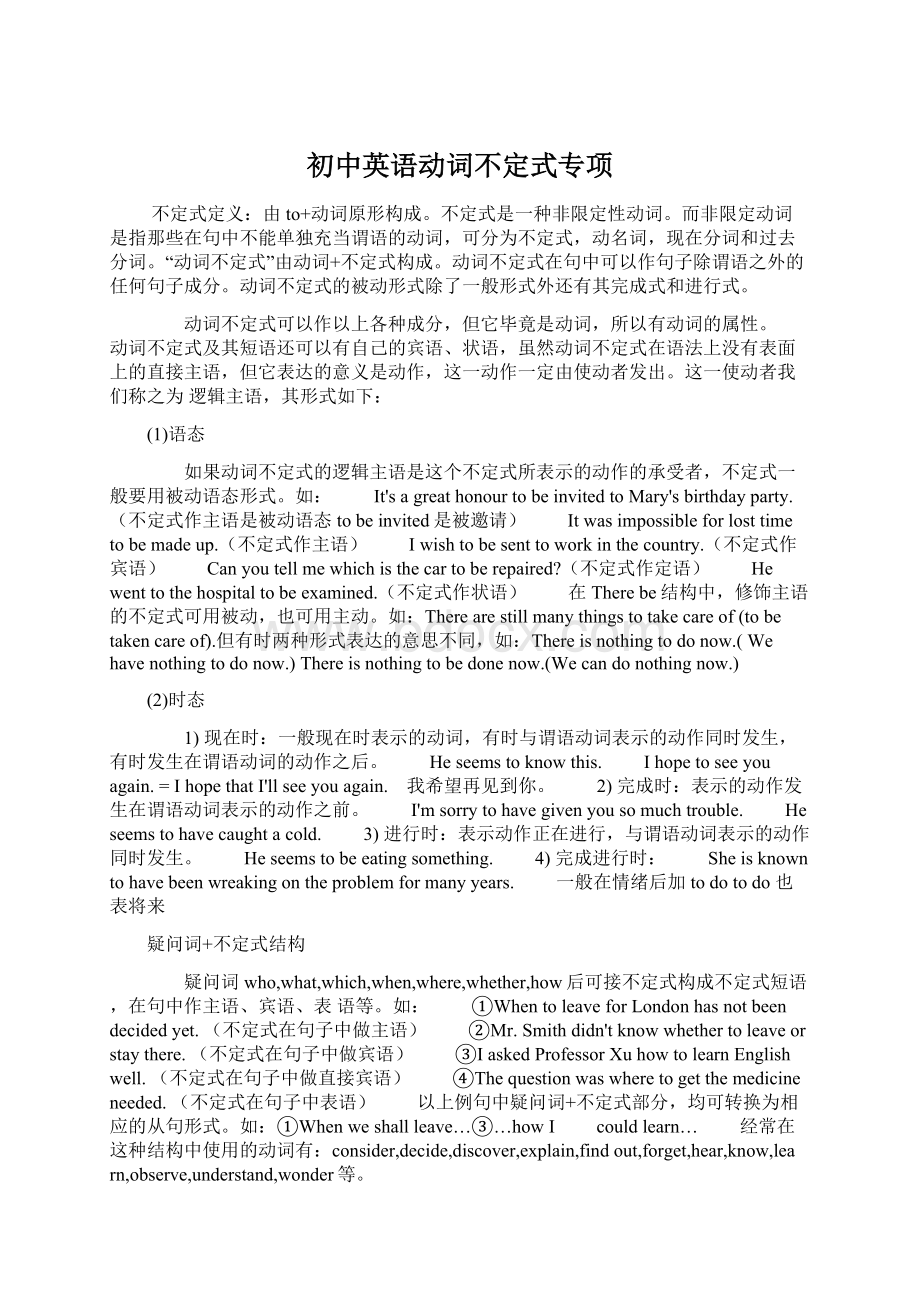初中英语动词不定式专项.docx
《初中英语动词不定式专项.docx》由会员分享,可在线阅读,更多相关《初中英语动词不定式专项.docx(16页珍藏版)》请在冰豆网上搜索。

初中英语动词不定式专项
不定式定义:
由to+动词原形构成。
不定式是一种非限定性动词。
而非限定动词是指那些在句中不能单独充当谓语的动词,可分为不定式,动名词,现在分词和过去分词。
“动词不定式”由动词+不定式构成。
动词不定式在句中可以作句子除谓语之外的任何句子成分。
动词不定式的被动形式除了一般形式外还有其完成式和进行式。
动词不定式可以作以上各种成分,但它毕竟是动词,所以有动词的属性。
动词不定式及其短语还可以有自己的宾语、状语,虽然动词不定式在语法上没有表面上的直接主语,但它表达的意义是动作,这一动作一定由使动者发出。
这一使动者我们称之为逻辑主语,其形式如下:
(1)语态
如果动词不定式的逻辑主语是这个不定式所表示的动作的承受者,不定式一般要用被动语态形式。
如:
It'sagreathonourtobeinvitedtoMary'sbirthdayparty.(不定式作主语是被动语态tobeinvited是被邀请) Itwasimpossibleforlosttimetobemadeup.(不定式作主语) Iwishtobesenttoworkinthecountry.(不定式作宾语) Canyoutellmewhichisthecartoberepaired?
(不定式作定语) Hewenttothehospitaltobeexamined.(不定式作状语) 在Therebe结构中,修饰主语的不定式可用被动,也可用主动。
如:
Therearestillmanythingstotakecareof(tobetakencareof).但有时两种形式表达的意思不同,如:
Thereisnothingtodonow.(Wehavenothingtodonow.)Thereisnothingtobedonenow.(Wecandonothingnow.)
(2)时态
1)现在时:
一般现在时表示的动词,有时与谓语动词表示的动作同时发生,有时发生在谓语动词的动作之后。
Heseemstoknowthis. Ihopetoseeyouagain.=IhopethatI'llseeyouagain. 我希望再见到你。
2)完成时:
表示的动作发生在谓语动词表示的动作之前。
I'msorrytohavegivenyousomuchtrouble. Heseemstohavecaughtacold. 3)进行时:
表示动作正在进行,与谓语动词表示的动作同时发生。
Heseemstobeeatingsomething. 4)完成进行时:
Sheisknowntohavebeenwreakingontheproblemformanyyears. 一般在情绪后加todotodo也表将来
疑问词+不定式结构
疑问词who,what,which,when,where,whether,how后可接不定式构成不定式短语,在句中作主语、宾语、表语等。
如:
①WhentoleaveforLondonhasnotbeendecidedyet.(不定式在句子中做主语) ②Mr.Smithdidn'tknowwhethertoleaveorstaythere.(不定式在句子中做宾语) ③IaskedProfessorXuhowtolearnEnglishwell.(不定式在句子中做直接宾语) ④Thequestionwaswheretogetthemedicineneeded.(不定式在句子中表语) 以上例句中疑问词+不定式部分,均可转换为相应的从句形式。
如:
①Whenweshallleave…③…howI couldlearn… 经常在这种结构中使用的动词有:
consider,decide,discover,explain,findout,forget,hear,know,learn,observe,understand,wonder等。
语法功能
一、作主语
动词不定式作主语时,句子的谓语动词常用单数,其位置有以下两种:
(1)把不定式置于句首。
如:
Togettherebybikewilltakeushalfanhour.
(2)用it作形式主语,把真正的主语不定式置于句后,常用于下列句式中。
如:
①It+be+名词+todo It'sourdutytotakegoodcareoftheold. ②Ittakessb+sometime+todo Howlongdidittakeyoutofinishthework?
③It+be+形容词+forsb+todo Itisdifficultforustofinishwritingthecompositioninaquarterofanhour. ④It+be+形容词+ofsb+todo Itisstupidofyoutowritedowneverything(that)theteachersays. ⑤Itseems(appears)+形容词+todo Itseemedimpossibletosavemoney. 在句型③中,常用表示客观情况的形容词,如:
difficult,easy,hard,important,impossible,necessary等;在句型④中,常用careless,clever,good,foolish,honest,kind,lazy,nice,right,silly,stupid,wise等表示赞扬或批评的词。
在不定式前的sb,可看作其逻辑主语。
这一句式有时相当于Sbis+形容词+todo句式,如:
It'skindofyoutohelpmewithmyEnglish.=YouarekindtohelpmewithmyEnglish. (3)举例
(1)It'seasy(forme)todothat.我做这事太容易了 easy, difficult, hard, important, possible, impossible, comfortable, necessary, better; thefirst, thenext, thelast, thebest, toomuch, toolittle, notenough It'ssonicetohearyourvoice. 听到你的声音真高兴。
It'snecessaryforyoutolockthecarwhenyoudonotuseit. 当你不用车的时候,锁车是有必要的。
(2)It'sverykindofhimtohelpus. 他帮助我们,他真好。
Kind, nice, stupid, rude, clever, foolish, thoughtful, thoughtless, brave, considerate(考虑周到的), silly, selfish(自私的) 例句:
Itwassillyofustobelievehim. 我们真愚蠢,竟然相信了他。
Itseemedselfishofhimnottogivethemanything. 他不给他们任何东西,这显得太自私了。
注意:
(1)其他系动词如,look,appear等也可用于此句型
(2)不定式作为句子成分时,动词用单数形式。
(3)当不定式作主语的句子中又有一个不定式作表语时,不能用Itis…to…的句型 (对)Toseeistobelieve. 眼见为实。
(错)Itistobelievetosee.
二、作宾语
1)以下动词后,只能跟不定式作宾语 afford(付得起),agree(同意),aim(力求做到),appear(显得),arrange(安排),ask(要求),attempt(试图),care(想要),choose(决定),claim(声称),condescend(屈尊),consent(准许),decide(决定),demand(要求),determine(决心),endeavor(竭力),expect(期待),fail(未履行),help(帮助),hesitate(犹豫),hope(希望),learn(学会),manage(设法),neglect(疏忽),offer(主动提出),plan(计划),prepare(准备),pretend(假装),proceed(接着做),promise(答应),prove(证明),refuse(拒绝),resolve(解决),seem(觉得好像),swear(发誓),tend(往往会),threaten(预示),undertake(承诺),volunteer(自愿做),vow(发誓),want(想要),wish(希望) 举例:
Thedriverfailedtoseetheothercarintime. 司机没能及时看见另一辆车。
Ihappentoknowtheanswertoyourquestion. 我碰巧知道你那道问题的答案。
2)动词+疑问词+不定式 decide,know,considerforget,learn,remember,show,understand,see,wonder,hear,findout,explain,tell Pleaseshowushowtodothat.请演示给我们如何去做。
Therearesomanykindsoftape-recordersonsalethatIcan'tmakeupmymindwhichtobuy.有这么多的录音机,我都拿不定主意买哪一种。
注意:
疑问词带不定式在句中作成分时,谓语动词用单数。
Thequestionishowtoputitintopractice. 问题是怎样把它付诸实施。
3)当复合宾语中的宾语是不定式时,先用形式宾语it代替不定式,把不定式置于补语之后,即:
主语+动词+it+补语+todo句式。
如:
Wethinkitquiteimportantforustolearnaforeignlanguagewell. Hefeelsithisdutytohelpthepoor. IfinditdifficulttolearnEnglishwell.
三、作补语
1)动词+宾语+不定式(todo) advise allow believe cause challenge compel declare encourage forbid force find hire induceinstruct invite like order permit persuade remind request require select send suppose tell train urge 例句:
a. Fatherwillnotallowustoplayonthestreet. 父亲不让我们在街上玩耍。
b. Webelievehimtobeguilty. 我们相信他是有罪的。
Find的特殊用法:
Find后可用分词做宾补,或先加形式宾语,再加形容词,最后加带to的动词不定式。
find后也可带一个从句。
此类动词还有get,have。
Ifoundhimlyingontheground. Ifounditimportanttolearn. IfoundthattolearnEnglishisimportant. 典型例题:
Thenextmorningshefoundtheman___inbed,dead. A.lying B.lie C.lay D.laying 答案:
A.find的宾语后面,用分词或分词短语,起宾语补足语作用。
现在分词表达主动,也表达正在进行,过去分词表达被动。
2)to+be的不定式结构,作补语的动词。
Acknowledge, believe, consider, think, declare(声称), discover,fancy(设想), feel, find, guess, judge, imagine, know, prove, see(理解),show, suppose, take(以为), understand WeconsiderTomtobeoneofthebeststudentsinourclass. 我们认为汤姆是班上最好的学生之一。
典型例题 CharlesBabbageisgenerallyconsidered ___thefirstcomputer. A.toinvent B.inventing C.tohaveinvented D.havinginvented 答案:
A.由considertodosth.排除B、D,此句只说明发明这一个事实,不定式后用原形即可。
而C为现在完成时,发明为点动词一般不用完成时,且此处也不强调对现在的影响,因此不选C。
3)tobe+形容词 Seem, appear, besaid, besupposed, bebelieved, bethought, beknown, bereported, hope,wish, desire, want, plan, expect, mean… Thebookisbelievedtobeuninteresting. 人们认为这本书没什么意思。
4) therebe+不定式 believe,expect,intend,like,love,mean,prefer,want,wish,undrstand Wedidn'texpecttheretobesomanypeoplethere.我们没料到会有那么多人在哪里。
有些动词需用as短语做补语,如regard,thinkbelieve,take,consider. WeregardTomasourbestteacher. 我们认为汤姆是我们最好的老师。
Marytookhimasherfather. 玛丽把他当作自己的父亲。
5)秃头不定式作补语 秃头不定式,即不带“to”的不定式,其语法功能一般在句子中作宾语的补语(宾语补足语)。
用秃头不定式作宾语补足语的常用动词如下:
口诀:
“五看、三使役“,“两听、一感”要记住,若是“宾补”变“主补”,主补“to”字不能无。
动词let属例外,其宾补/主补“to”均无。
说明:
五看-----see/watch/notice/observe/lookat;三使役-----have/make/let;两听-----hear/listento;一感-----feel。
例句:
Ioftenseehimgotoschoolonfoot.(秃头不定式作宾语补足语)Heisoftenseentogotoschoolonfoot.(不定式作主语补足语,要带“to”)Lethimtryagain.----Heislettryagain.(let的主补与宾补均用秃头不定式)
四、作表语
不定式作表语表示具体动作或将来动作;动名词作表语表示抽象的一般行为。
①Tobekindtotheenemyistobecrueltothepeople. ②Mychiefpurposeistopointoutthedifficultiesofthematter. ③WhatIwouldsuggestistoputoffthemeeting. 当主语和表语都是不定式时,其含义一是条件,一是结果(例①)。
当主语是aim,duty,hope,idea,mistake,plan,purpose,suggestion等为中心词的名词词组(例②)时,或以what引导的名词性分句(例③),不定式说明主语的内容。
④Ourworkisservingthepeople. ⑤Whathelikesistakingawalkaftersupper. ⑥ThestorytoldbyMr.Wangisinteresting. ④⑤句动名词作表语,与主语部分可以转换,如Servingthepeopleisourwork,而⑥句中是现在分词作表语,说明主语的性质、状态,现在分词具有形容词的各种特征,另外,动名词作表语还应与进行时态区别开来。
五、作状语
(1)目的状语 To…onlyto(仅仅为了), inorderto, soasto, so(such)…asto…(如此……以便……) Heransofastastocatchthefirstbus. 他飞快地跑以便赶上第一班车。
Icomehereonlytosaygood-byetoyou. 我来仅仅是向你告别。
(2)作结果状语,表事先没有预料到的,要放在句子后面。
WhathaveIsaidtomakeyouangry. Hesearchedtheroomonlytofindnothing. (3) 表原因 I'mgladtoseeyou. 典型例题 Thechairlooksratherhard,butinfactitisverycomfortableto___. A.sit B.siton C.beseat D.besaton 答案:
B. 如果不定式为不及物动词,其后应有必要的
介词
。
当动词与介词连用时,常位于“形容词+动词不定式”结构的末尾。
六、作定语
⒈不定式作定语 不定式在句中作定语,置于被修饰的名词或代词之后。
如:
①ThenexttraintoarriveisfromWashington. ②Doyouhaveanythingtobetakentoyoursister?
③Doyouhaveanythingtosayonthequestion?
④Wouldyoupleasegivemesomepapertowriteon?
⑤MywishtovisitFrancehascometrueatlast. 不定式短语作定语和被修饰词之间表示以下关系:
(1)表示将来的动作(例①)。
(2)与被修饰词之间有动宾关系,如是不及物动词,则需加介词(例④)。
(3)与被修饰词之间有动宾关系,同时与句中其它词之间又有逻辑上的主谓关系时,尽管有被动含义,却仍用主动语态(例③);如只有动宾关系,而无逻辑上的主谓关系,则需用被动语态(例②)。
(4)不定式作定语时,一般可转换为定语从句,例①toarrive=thatwillarrive。
省to的动词不定式
介绍
(1)情态动词(除ought外,oughtto意思是“应该”,是情态动词,只有一种形式,后边接动词不定式,to不能省略。
oughtto没有人称和数的变化,后接动词原形可以表示现在、将来或过去将来,由时间状语或上下文决定。
例如:
Theyoughttocometomorrow.他们明天应当来):
(2)使役动词let,have,make:
(3)感官动词see,watch,lookat,notice,observe,hear,listento,smell,feel,find等后作宾补,省略to。
注意:
在被动语态中则to不能省掉。
在使役动词中get除外(getsb.todosth.) Isawhimdance. =Hewasseentodance. Thebossmadethemworkthewholenight. =Theyweremadetoworkthewholenight. (4)表示个人意愿或倾向的wouldrather,hadbetter,might(just)aswell:
ratherthan置于句首时。
Ratherthanrideonacrowdedbus,healwayspreferstorideabike. (5)Why…/whynot…:
(6)help可带to,也可不带to,helpsb(to)dosth:
(7)but和except:
but前是动词do时,后面出现的动词用不带to的动词不定式。
(8)由and,or和than连接的两个不定式,第二个to可以省去:
(9)通常在discover,imagine,suppose,think,understand等词后,可以省去tobe:
Heissupposed(tobe)nice. 他应该是个好人。
(10)but作介词,后接不定式结构时,前面谓语动词部分若含有do的形式时,but后的不定式要省去to,否则要带to。
Hewantstodonothingbutgoout. Hewantstobelieveanythingbuttotakethemedicine. (11)当两个或多个不定时短语由连词and,but或or连接时,后一个或几个不定式符号to常省略。
但若表示对比、对照关系时,则不能省略。
HewantstomovetoFranceandmarrythegirl. Thepurposeofnewtechnologiesistomakelifeeasier,nottomakeitmoredifficult. (12)不定式做表语时,一般要带to,但若主语部分中含有do的各种形式时,符号to可省去。
We'vemissedthelastbus.Allwecoulddono